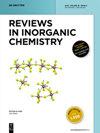A review of carbon-based adsorbents for the removal of organic and inorganic components
IF 3.1
3区 化学
Q1 CHEMISTRY, INORGANIC & NUCLEAR
引用次数: 0
Abstract
Carbon-based adsorbents like graphene and its derivatives, carbon nanotubes, activated carbon, and biochar are commonly used for removing heavy metals from water solutions. The changeable exterior functional groups of efficient carbon adsorbents for HMs are one of their key features. Detailed documentation of the synthesis and interactions of functionalized carbon adsorbents with metals in an aqueous solution is crucial for advancing the utilization of these materials in HM exclusion. This paper reviews the carbon-based adsorbent for material removal. It examines several carbon adsorbents’ exterior functional groups to better understand how they eliminate HMs from aqueous solutions. First, the controlling mechanisms for the deletion of aqueous HMs by carbon adsorbents are described, with a particular emphasis on the functions of exterior functional groups. The following section lists and organises the numerous synthetic techniques that are frequently employed to add heteroatoms to carbon surfaces, particularly oxygen, nitrogen, and sulphur, to increase their exterior properties and their sorptive capabilities towards HMs in aqueous solutions. Following that, the impact of dissimilar functional groups on the adsorption characteristics of HMs on carbon adsorbents is examined. While the adsorption capacity and metal removal efficiency of the changed carbonaceous materials are high, the alteration operation is complicated, particularly chemical modification. This review analyses the shortcomings that are now present and offers ideas for future research while emphasising the removal of inorganic and organic components utilising carbon-based materials as adsorbents. In summary, there is room for additional study on the efficacy of functional carbon adsorbents for the removal of heavy metals and their potential uses in various fields. This includes the development of new materials and techniques to enhance adsorption efficiency and selectivity for specific heavy metals, along with the investigation of additional functionalities for these carbon adsorbents in various industrial processes. There is a need for continued innovation and collaboration in this field to address the growing concerns regarding heavy metal pollution and to explore the full capabilities of functional carbon adsorbents.碳基吸附剂去除有机和无机成分综述
石墨烯及其衍生物、碳纳米管、活性炭和生物炭等碳基吸附剂常用于去除水溶液中的重金属。吸附重金属的高效碳吸附剂可改变外部官能团是其主要特点之一。详细记录功能化碳吸附剂的合成及其与水溶液中金属的相互作用,对于推动利用这些材料排除 HM 至关重要。本文回顾了用于去除材料的碳基吸附剂。它研究了几种碳吸附剂的外部官能团,以更好地了解它们是如何从水溶液中去除 HM 的。首先,介绍了碳吸附剂去除水溶液中 HMs 的控制机制,并特别强调了外部官能团的功能。下一节列出并整理了大量常用的合成技术,这些技术可在碳表面添加杂原子,特别是氧、氮和硫,以增加碳的外部特性及其对水溶液中 HMs 的吸附能力。随后,我们研究了不同官能团对碳吸附剂上 HMs 吸附特性的影响。虽然改变后的碳质材料具有较高的吸附能力和金属去除效率,但改变操作复杂,尤其是化学改性。本综述分析了目前存在的不足,并为今后的研究提供了思路,同时强调了利用碳基材料作为吸附剂去除无机和有机成分。总之,对于功能性碳吸附剂去除重金属的功效及其在各个领域的潜在用途,还有进一步研究的空间。这包括开发新材料和新技术,以提高对特定重金属的吸附效率和选择性,以及研究这些碳吸附剂在各种工业流程中的其他功能。该领域需要不断创新和合作,以解决人们日益关注的重金属污染问题,并探索功能性碳吸附剂的全部功能。
本文章由计算机程序翻译,如有差异,请以英文原文为准。
求助全文
约1分钟内获得全文
求助全文
来源期刊

Reviews in Inorganic Chemistry
化学-分析化学
CiteScore
7.30
自引率
4.90%
发文量
20
审稿时长
1 months
期刊介绍:
Reviews in Inorganic Chemistry (REVIC) is a quarterly, peer-reviewed journal that focuses on developments in inorganic chemistry. Technical reviews offer detailed synthesis protocols, reviews of methodology and descriptions of apparatus. Topics are treated from a synthetic, theoretical, or analytical perspective. The editors and the publisher are committed to high quality standards and rapid handling of the review and publication process. The journal publishes all aspects of solid-state, molecular and surface chemistry. Topics may be treated from a synthetic, theoretical, or analytical perspective. The editors and the publisher are commited to high quality standards and rapid handling of the review and publication process.
Topics:
-Main group chemistry-
Transition metal chemistry-
Coordination chemistry-
Organometallic chemistry-
Catalysis-
Bioinorganic chemistry-
Supramolecular chemistry-
Ionic liquids
 求助内容:
求助内容: 应助结果提醒方式:
应助结果提醒方式:


